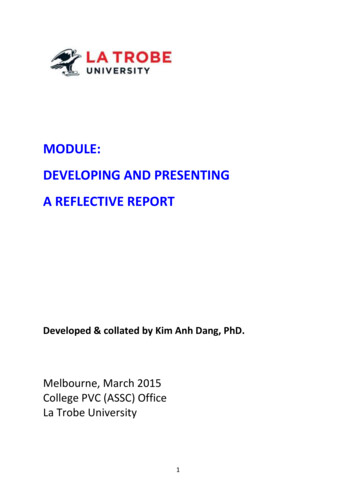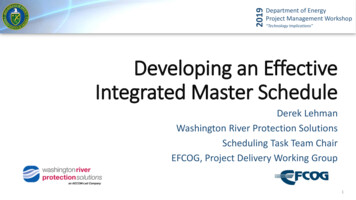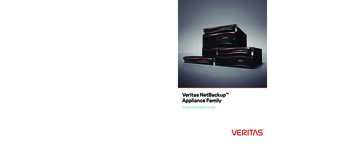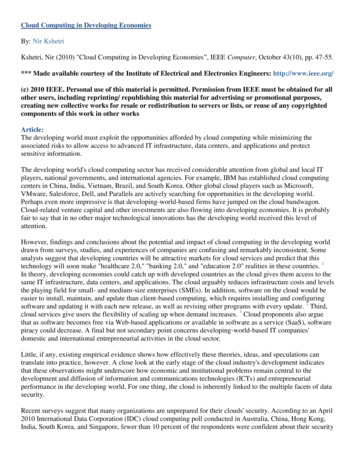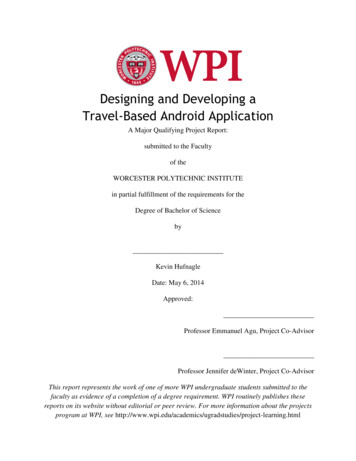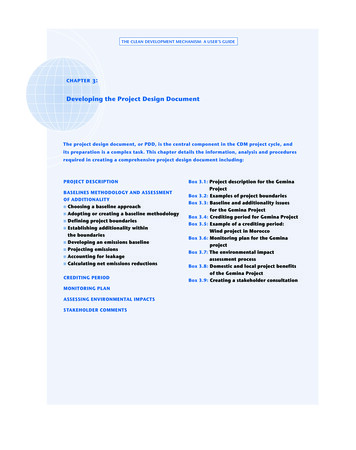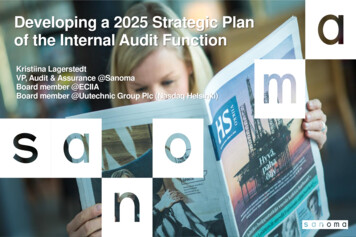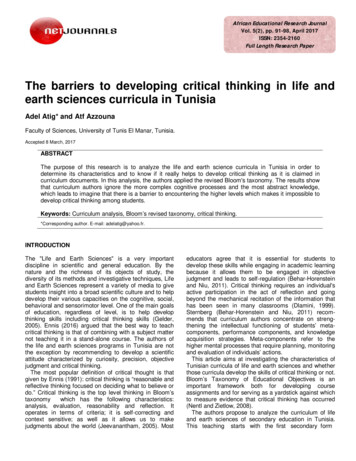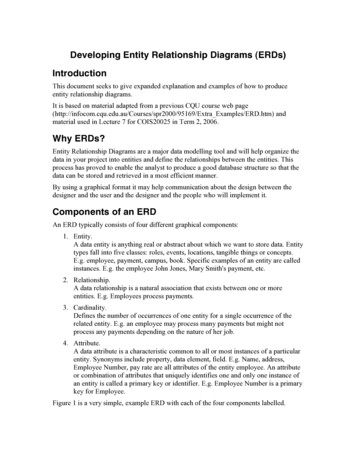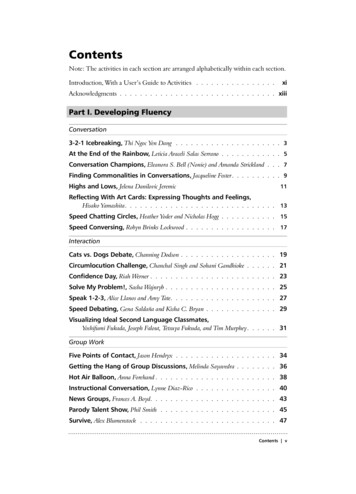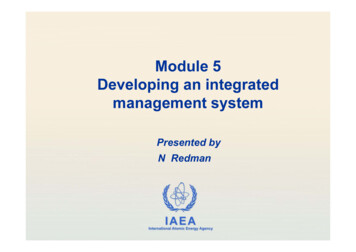
Transcription
Module 5Developing an integratedmanagement systemPresented byN RedmanIAEAInternational Atomic Energy Agency
Gap analysis1There are various types of analysis thatwill be needed to help you define thescale, scope and potential impact of thetransition to the IAEA documents.BGAP analysis is particularly helpfulhere:1. What is point B: Where are you tryingto take the organisation; what does thenew system look like?32. What is the point A: Where are younow by comparison with point B?3. What are the changes needed toclose this THETHEGAPGAP2
What is your gap?AA21APoint B – We have implemented aManagement System that addresses all thenew IAEA OTOCLOSECLOSETHETHEGAPGAPYou could all be starting at a different point A!IAEA3
Which point A are you?AA12A3A4A5No management systemSeparate management systems that donot use processesAn integrated management system that does notuse processes to describe its activitiesSeparate management systems that use processes(e.g. safety, environment, financial and quality)Any other option I’ve forgotten to mention!!!!IAEA4
Whichever point A you are at Review the IAEA documents and carry out a gap analysis toestablish your point A (what requirements and guidance are younot addressing) Appoint a project leader and establish a project team Develop plans for the project to develop the managementsystem Obtain approval of the plan and ensure resources are provided Develop plans for communication Examine the commonalities between various managementsystems such as documentation control, records andassessmentsIAEA5
Alignment is the keyManagementcommitment &leadership withunity of purposeMission, VisionPoliciesBusiness plan & objectivesProcessesSupporting proceduresIAEAWork InstructionsStaff participation& involvementthat supportsaccomplishment6
Developing a process approach Identify the process model of the organization – e.g. core,management and support processesDetermine how the processes interact to enable theachievement of the organization’s objectives.Develop a logical document and process hierarchyIdentify process owners and train themDevelop the processes with the process owners and otherinterested partiesReview current documentation for completeness and relevanceDevelop an implementation plan, train the staff and implementthe processesIAEA7
Process Mapping Develop a generic processmapping style for the organisation– there are many available Identify current activities orprocess steps (noun & verb) Arrange these into a logicalsequenceIAEA8
Within each process Agree the ‘purpose’ and ‘scope’ of each process Identify what work is done, who carries it out and howit is performed Identify the resource needs (in terms of individuals,finance and equipment) Clarifying the constraints or requirements that affecthow the process operates Make sure the inputs and outputs are identifiedIAEA9
Process can be decomposed into smallercomponents that make up a hierarchy.An example of a hierarchy:Support ProcessMajor-processes- Support Process Design safety management- Departmental Process Produce Safety analysisSub-processDepartmentalProcess- Sub-process Asses Safety analysis- Activities Conduct independent peer review- Tasks Review assumptions Check ivities and tasks are often described in proceduresTasks10
GS-R-3 – Developing Processes5.4. The development of each process shall ensure that thefollowing are achieved: Process requirements, such as applicable regulatory,statutory, legal, safety, health, environmental, security,quality and economic related requirements, are specifiedand addressed; Hazards and risks are identified, together with anynecessary mitigatory actions; Interactions with interfacing processes are identified; Process inputs are identified; The process flow is described; Process outputs (products) are identified; Process measurement criteria are established.IAEA11
The management system building blockDrivers/ConstraintsContractual documentsStandardsSite Licence OCESSOutputTransformed MaterialTransformed InformationEquipmentPeopleMoneyResourcesIAEA12
Implementation stem. ffromtherestoftheorganisation.and cut off from the rest of the organisation.Decision makingDecision makingIt should be clear where decisions areIt should be clear where decisions aremade within the organisation. Seniormade within the organisation. Seniormanagement should understand themanagement should understand theinter-relationship between decisionsinter-relationship between decisionsand how they impact on each other.and how they impact on each other.Decisions that divert resources fromDecisions that divert resources fromimplementation should be properlyimplementation should be &&OrganisationOrganisationImplementing a management system isImplementing a management system ananalienaliencultureandorganisationsystem.culture and organisation system. can-docan-doculturecultureprovides the necessary context.provides the necessary nforceit.rewards and training, reinforce psupport, are the critical leadershipcontributions.contributions.Business PlanningBusiness newgoals and objectives for the newBusiness managementmanagementsystemsystem- -fromfromPlanning organisationto individual level. BPorganisation to individual level. BPenables the organisation’senables the organisation’sresources, to be focused onresources, to be focused onmanagement system development.management system development.Accountability & Accountability & ControlAccountability & ControlControl Followingthrough, and knowing whatFollowing through, and knowing whatEnablingCulture ctureImplementation requires infrastructure Implementation requires infrastructure lethatthatidentified in a project plan. A projectidentified in a project plan. A lementationonontrack.track. ntrolcontrolsystemssystemsarearethethekey.key.
Process OwnersAll processes should have a clearly defined Process Ownerwho is responsible and accountable for: Identifying the inputs, outputs, constraints and resourcesfor each process Developing and documenting their process and supportingdocumentation (procedures, working practices, recordformats etc.) Providing the signpost to any current supportingdocuments including aligning them to the processes revising where necessary withdrawing obsolete or superseded documentsIAEA14
Process Owners part 2 Ensuring process documentation incorporates any relevant legal or industry requirementsEnsuring that the records requirements are specifiedwithin the process documentationMonitoring the performance of the process to ensurethe process remains effectiveEnsuring staff who are required to work in theprocess are trained/familiar with the process andprocess documentsCo-operating with the Process Owners of interfacingprocesses.IAEA15
Understand there are different categories ofprocessThe IAEA documents recognise 3 categories of processes: Management processes Core Processes (sometimes called key or businessprocesses) Support ProcessesIAEAWhile these threecategories playsignificantlydifferent roles,they must bealigned andintegrated toenable effectiveperformance ofthe organization16
Management ProcessesThese provide direction and governance for anorganization. They are generally implemented by seniormanagement to: set organizational goals direct and manage the organization manage external relationships and interfaces manage and improve the processes assess and improve performance of work.Management processesalso shape and managethe core and supportprocesses used by anorganizationIAEA17
Identifying core processesThe following questions may help you identify core processes: What are the critical outputs of the organization and which processesdeliver these?Which processes reflect the unique competencies of the organizationand are mission-critical?Which processes are the value-creating activities of the organizationand are the processes that are seen and experienced by externalcustomers?Which processes have the greatest impact on profitability?Which processes are so important to our competitive position that wewould never outsource them?Which processes have the greatest impact on performance (safety,quality, cost, speed, innovation)? ·IAEA18
Support processesSupport processes exist to sustain the organization. Sincethe support needs of many organizations are similar, theseprocesses tend to be fairly standard and are frequentcandidates for outsourcing. The customers of supportprocesses are internal customers – within the organization.They include processes such as: Provide financial resources Provide human resources Provide emergency preparedness Provide security Provide environmental monitoring Provide information technology support Provide materials and procurement support Provide documentation and recordsIAEA19
Have we identified all our processes?For an operational nuclear plant here are some standardswhich are worth cross-checking against:The reference documents (IAEA guides) mentioned in DS 349IAEA Safety Guides on Operation (NS-G-2.1 through 2.10)TECDOC-1078, Technical Support for Nuclear Power OperationsINSAG-13, Management of Operational Safety in Nuclear Power PlantsWANO Performance Objectives and CriteriaAn Owners’ Group’s concept for plant management, e.g. the StandardNuclear Performance Model IAEA Safety Guide DS 347, Conduct of operation at nuclear power plants IAEA20
Don’t try and develop an integrated managementsystem from a bottom up approach, byidentifying requirements from managementsystem standards or without the buy-in andsupport of your management teamIT WON’T WORK !!!!!!!IAEA21
In Conclusion - Expected benefits Increased focus on safety All the processes of the organization are identified All requirements are addressed The goals, strategies, plans and objectives of the organization are morelikely to be achieved All supporting documentation can be identified & referenced from aprocess More concise management system with all aspects adding value Enhanced communication through simplicity and uniformity Better risk identification and management Enhanced stakeholder understanding and satisfaction Accelerated training and reduction in training needs A system that management can see some benefit in having Buy-in and use at all levels in the organizationIAEA22
Objectives of this training package were tohelp top managers: Understand the structure and content of the IAEA safety guides and safety publicationsUnderstand why it is beneficial to have a coherentmanagement system that addresses all requirements in astructured way using processes.Understand the appropriateness of all the managementsystem standards to a nuclear utility.Understand the roles and responsibilities of seniormanagers and how leadership supports the developmentand implementation of the management system.How to align the management system to the goals andobjectives of the utility and transition the currentmanagement system to the GS-R-3 approach.IAEA23
Questions and AnswersQuestions to Module 5IAEA24
track. Clear systems of accountability and effective, balanced control systems are the key. Accountability & Control Following through, and knowing what is going on, keep implementation on track. Clear systems of accountability and effective, balanced control systems are the key. Business Pla
